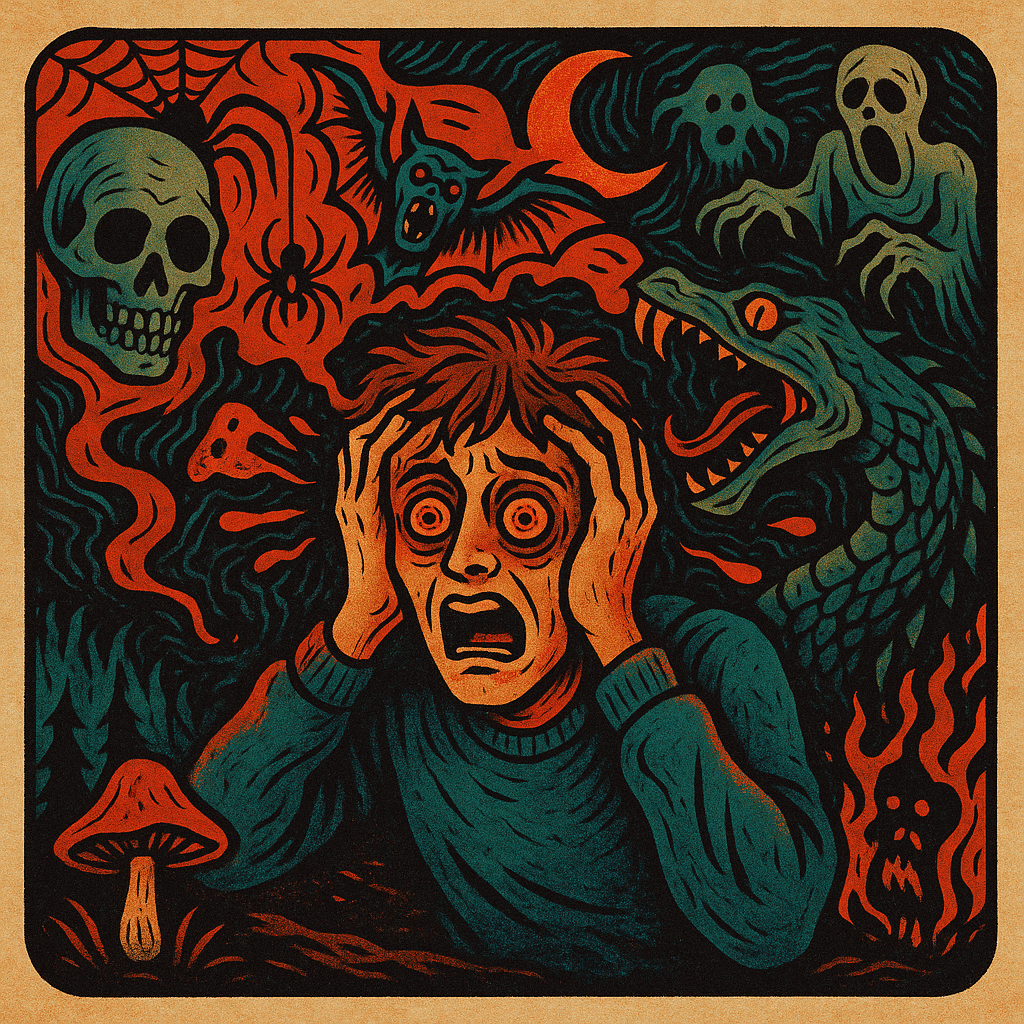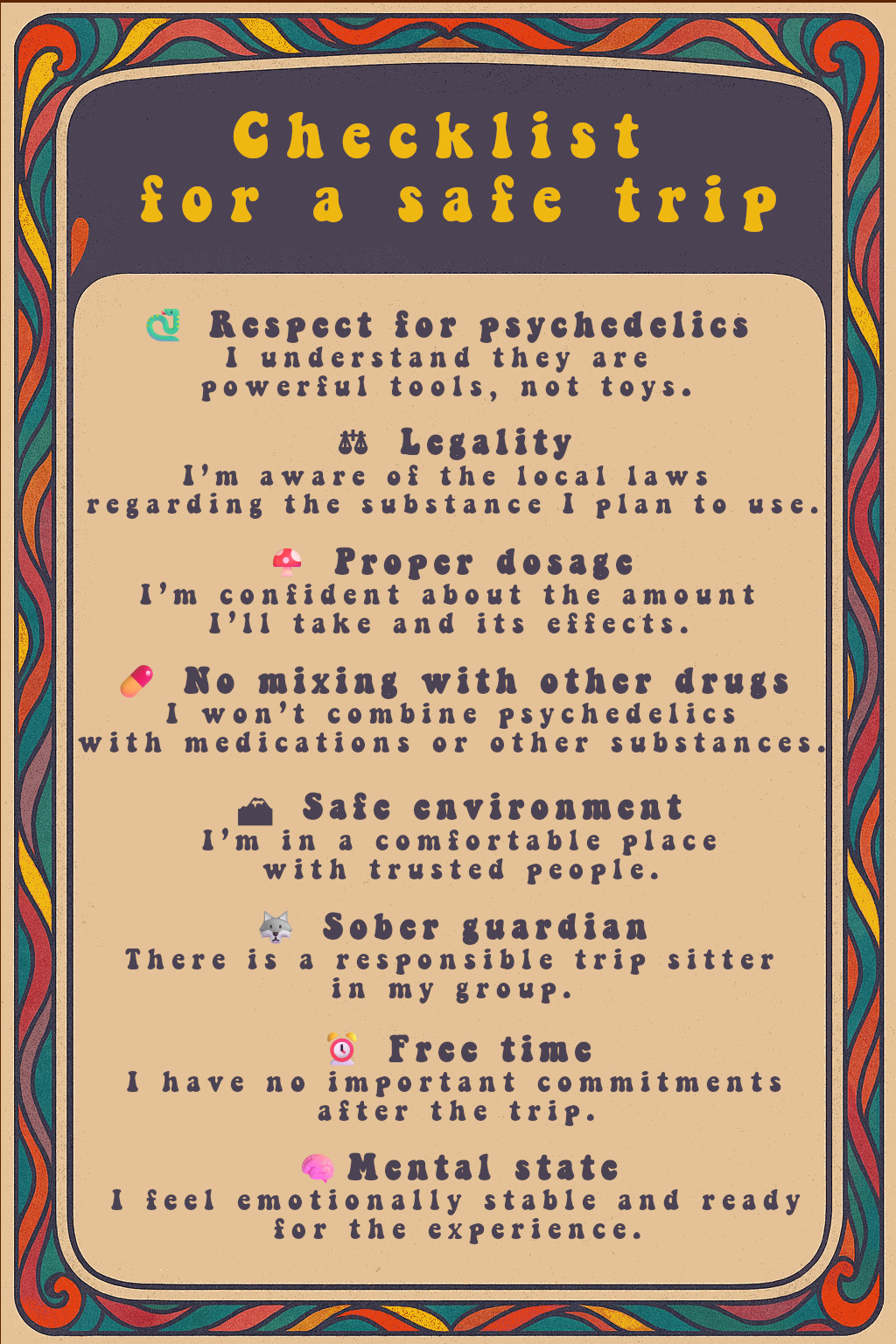Set and setting: A guide to safe travel with psychedelics
- Why are Set and Setting so important?
- The Four Pillars of "Set and Setting"
- 1. Mindset (Set): Prepare Your Mind for the Journey
- 2. Setting: Create a Safe and Comfortable Space
- 3. Trip Sitter: The Anchor of Your Journey
- 4. Substance: Know What You're Taking
- When Does Psychedelic Use Become Irresponsible?
- How to Handle a Difficult Psychedelic Trip
Psychedelics like magic mushrooms, LSD, or salvia can offer transformative, creative, and even therapeutic experiences. However, their full potential unfolds only when used responsibly and with respect. Since ancient times, these substances have been revered in sacred rituals, but today, many people consume them without preparation, exposing themselves to unnecessary risks.

In this article, we'll explore what safe tripping means, the essential pillars for a positive experience, how to avoid dangers and handle difficult moments. If you're thinking of embarking on a psychedelic journey, this guide is for you!
Why are Set and Setting so important?
We don't know exactly when humans began using psychedelics—their history predates writing—but there are fascinating theories, such as the "Stoned Ape Theory," suggesting that psychedelic mushrooms may have influenced the evolution of our consciousness. In the past, these substances were part of carefully designed ceremonies, with strict protocols to honor their power. Today, the context has shifted: many use them recreationally, sometimes ignoring their deep effects on mind and body.
A psychedelic trip can be a gateway to introspection, creativity, or healing, but it can also be overwhelming or risky without precautions. "Set and setting" not only minimize risks—they maximize benefits, turning a potentially chaotic experience into something enriching. Below, we share the key principles to achieve this.
The Four Pillars of "Set and Setting"
Responsible psychedelic use is based on four core pillars: mindset (set), environment (setting), sitter (trip sitter), and substance. Let’s break them down so you know how to apply them.
1. Mindset (Set): Prepare Your Mind for the Journey
Your mental state before taking psychedelics is the foundation of the experience. These substances don't automatically make you happy—they amplify what you already feel. If you're anxious, paranoid, or sad, the trip could intensify those emotions, making things uncomfortable. But if you approach it with optimism and openness, the chances of a positive journey increase.
Tips for a Healthy Mindset:
- Reflect: Am I emotionally ready? What do I want from this experience?
- Set an intention: It could be self-discovery, creativity, or simply enjoyment.
- Avoid pressure: Never take psychedelics out of obligation or peer influence.
Think of psychedelics as a mirror of your inner world. Preparing your mind is like cleaning that mirror so it reflects your best self.

2. Setting: Create a Safe and Comfortable Space
The environment where your trip takes place is just as important as your mindset. It includes the physical location (a house, park, forest) and the people with you. A bad setting—noisy, messy, or full of strangers—can turn a promising experience into chaos.
Characteristics of a Good Setting:
- Familiarity: A place you know well reduces anxiety.
- Privacy: Avoid interruptions from strangers.
- Comfort: Clean space with bathroom access and a quiet corner to rest.
- Nature: Outdoor settings are often ideal for psychedelics.
- Music: Prepare a relaxing playlist—sound strongly influences the trip.
The people you share your trip with are part of the setting too. Choose trusted companions with whom you feel safe and in sync. A positive group can elevate the experience; a toxic one can ruin it.
3. Trip Sitter: The Anchor of Your Journey
A trip sitter is a sober person who stays with the group during the trip. Their role is crucial: they maintain the environment, ensure safety, and offer emotional support if someone goes through a tough time. While psychedelics rarely cause physical emergencies when used correctly, a bad trip can leave someone feeling lost or scared—and that’s where the sitter shines.
Trip Sitter Responsibilities:
- Handle practical tasks: Answer the door, guide a walk, prepare food.
- Watch over the group: Spot signs of distress or danger.
- Provide comfort: Be a grounding presence for anyone going through a "bad trip."
A good sitter doesn’t judge or interfere unnecessarily—they're present as a calm guide. If you're planning a solo trip, at least inform someone you trust.
4. Substance: Know What You're Taking
The final pillar is the substance itself. Before taking any psychedelic, do your research:
- Correct dosage: Every substance has a safe range. For example, 1–2g of dried mushrooms (Psilocybe cubensis) is a moderate beginner dose.
- Risks and contraindications: Some substances should not be mixed with medications (like antidepressants) or health conditions (like psychotic disorders).
- Duration: Psilocybin lasts 4–6 hours; LSD up to 12. Knowing this helps you plan.
- Testing: Use testing kits to detect adulterants, like NBOMe in fake LSD or fentanyl in MDMA.
Example: taking salvia without understanding its intensity can be overwhelming. Preparation and testing are essential for a safe and predictable journey.
When Does Psychedelic Use Become Irresponsible?
Psychedelics aren't inherently good or bad—it all depends on how and why you use them. Ask yourself:
- Am I trying to escape something? Using them to avoid emotions or problems can lead to harmful cycles.
- Am I using them compulsively? While not physically addictive, psychological overuse can harm your health, finances, or relationships.
Historically, Indigenous cultures used substances like tobacco or magic mushrooms with sacred respect, without falling into addiction. The difference was in the intention: they saw them as tools for growth, not crutches. Today, modern society often uses them to avoid reality, which can lead to irresponsible use. Safe tripping means using psychedelics to learn, heal, or create—not to hide.
How to Handle a Difficult Psychedelic Trip
A difficult trip is not the same as a bad trip. In fact, many psychonauts say the most challenging moments—so-called "bad trips"—bring the most valuable lessons. Psychedelics don't always give you what you want, but rather what you need.
Strategies for Overcoming a Bad Trip
- Accept the experience: Resisting negative emotions or intense visions only increases fear. Let it flow—this too shall pass.
- Lean on your sitter: A trusted trip sitter can be your anchor, reminding you that you’re safe and that the trip is temporary.
- Change the setting: If possible, move to a calmer space or play soothing music to redirect the energy.
- Remember the duration: Even the most intense trips have an endpoint. Tell yourself: “This will end soon.”
In extreme cases, seek help from trained psychedelic facilitators or therapists. The key is not to fight the trip, but to navigate it with patience.
Risks of Ignoring Set and Setting
Skipping these principles can have consequences. For example:
- Adulterants: Without testing, you might ingest dangerous substances like NBOMe, which has caused fatalities.
- Bad environment: A chaotic place can trigger paranoia or panic.
- Lack of preparation: An unknown dose or fragile mental state can lead to overwhelming experiences.
Preparing for a trip isn’t just a precaution—it’s a way to honor the power of psychedelics and protect your well-being.

Travel Safe, Avoid Risks
"Set and setting" can transform psychedelic use from a risky adventure into a powerful tool for personal growth. With a positive mindset, a welcoming environment, a reliable sitter, and well-researched substances, you can unlock experiences that expand your perspective and enrich your life.
Whether you're seeking creativity, healing, or simple curiosity, responsible use is key.
Have a good (and safe) trip!




















